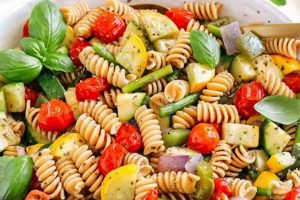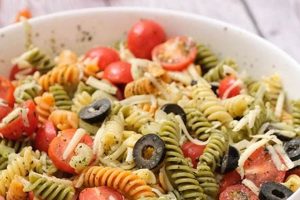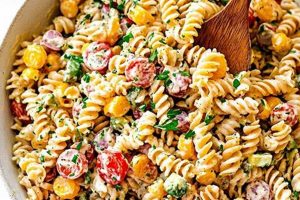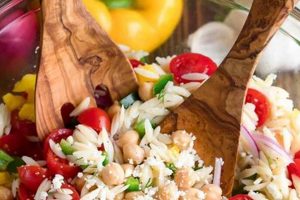A chilled dish featuring cooked pasta, canned tuna, and typically a mayonnaise-based dressing, often incorporates vegetables such as celery, onions, and peppers. Variations can include other ingredients like hard-boiled eggs, olives, or different herbs and spices. A simple example combines cooked rotini pasta, drained tuna, chopped celery and onion, mayonnaise, salt, and pepper.
This type of dish offers a convenient and nutritious meal option, particularly suitable for warm weather or quick lunches. It provides a good source of protein from the tuna, carbohydrates from the pasta, and can offer additional vitamins and minerals depending on the incorporated vegetables. Historically, pasta salads gained popularity in the mid-20th century as refrigeration became more commonplace, enabling the safe consumption of mayonnaise-based dishes. Their adaptability and ease of preparation contributed to their widespread appeal.
Further exploration will cover specific ingredient variations, preparation techniques, nutritional information, and tips for achieving optimal flavor and texture. Different dressing options and suitable accompaniments will also be discussed.
Tips for a Superior Pasta Salad with Tuna
Achieving a flavorful and well-balanced dish requires attention to detail. These tips offer guidance for optimizing ingredient selection and preparation techniques.
Tip 1: Pasta Selection: Opt for short, sturdy pasta shapes that hold their shape well and capture the dressing effectively. Rotini, farfalle, and penne are excellent choices. Avoid long, thin pasta like spaghetti or angel hair.
Tip 2: Tuna Quality: Select high-quality canned tuna packed in water or oil, ensuring it’s drained thoroughly before incorporating it into the salad. Solid or chunk light tuna generally offers the best texture.
Tip 3: Vegetable Crispness: Maintain vegetable crispness by adding them shortly before serving. If preparing the salad in advance, store vegetables separately and combine them just before consumption.
Tip 4: Dressing Balance: A well-balanced dressing is crucial. Avoid excessive mayonnaise, which can make the salad heavy. A combination of mayonnaise, plain yogurt, or a vinaigrette can create a lighter, more flavorful dressing.
Tip 5: Flavor Enhancement: Fresh herbs and spices elevate the overall flavor profile. Consider adding chopped dill, parsley, chives, or a pinch of red pepper flakes.
Tip 6: Chilling Time: Allow the salad to chill for at least 30 minutes before serving to allow the flavors to meld. This enhances the overall taste and texture.
Tip 7: Portion Control: Tuna salad can be calorie-dense. Be mindful of portion sizes to maintain a balanced meal.
By following these guidelines, one can create a pasta salad with tuna that offers a harmonious balance of flavors, textures, and visual appeal.
These tips provide a solid foundation for creating a successful dish. The following section will offer variations and further insights into customization.
1. High-quality Tuna
High-quality tuna plays a pivotal role in a successful pasta salad. Tuna provides the primary protein source and significantly influences the overall flavor profile. Opting for premium tuna packed in oil or water, rather than lower-grade options, results in a richer, more nuanced taste. Substandard tuna can possess a strong, fishy odor and a mushy texture, detracting from the final dish. For instance, using albacore tuna packed in olive oil adds a subtle richness and enhances the mouthfeel compared to chunk light tuna in water. This choice directly impacts the sensory experience, elevating the perceived quality of the entire salad.
The quality of tuna also affects the structural integrity of the salad. Inferior tuna tends to break down more readily during mixing, creating a less appealing, homogenous texture. Higher-quality tuna maintains its integrity, providing distinct flakes or chunks that contribute to a more desirable textural contrast against the pasta and vegetables. This distinction can be observed when comparing a salad made with premium solid tuna steaks versus one using pre-shredded tuna, the latter often resulting in a softer, less defined consistency.
Ultimately, selecting high-quality tuna represents a worthwhile investment in the overall culinary experience. While budget considerations often influence purchasing decisions, the difference in taste and texture between superior and inferior tuna significantly impacts the final product. The enhanced flavor, improved texture, and more appealing presentation justify the marginal increase in cost. This attention to detail elevates a simple pasta salad from a basic meal to a more refined and satisfying culinary creation.
2. Proper Pasta Choice
Pasta selection significantly influences the overall success of a tuna pasta salad. The pasta’s shape, size, and texture interact with the other ingredients, affecting the dish’s final flavor, presentation, and enjoyment. Choosing appropriately ensures the pasta complements, rather than detracts from, the other components.
- Shape and Structure:
Short, sturdy pasta shapes hold their form well when mixed with other ingredients and coated in dressing. Rotini, farfalle, and penne are ideal examples. Their complex shapes trap the dressing and small ingredients, distributing flavor evenly. Conversely, long, thin pasta like spaghetti becomes unwieldy and clumps together, hindering even coating and creating an unappetizing presentation.
- Size and Proportion:
The pasta’s size should be proportionate to the other ingredients. Overly large pasta overwhelms the tuna and vegetables, creating an unbalanced dish. Smaller pasta shapes, like ditalini, can become lost among the other components. Medium-sized pasta, such as fusilli or shells, provides a balanced visual and textural contrast.
- Cooking Method:
Properly cooked pasta is crucial. Overcooked pasta becomes mushy and absorbs too much dressing, leading to a heavy, unappealing texture. Undercooked pasta remains firm and unpleasant to chew. The pasta should be cooked al dente firm to the bite and rinsed under cold water to stop the cooking process and maintain its texture.
- Gluten Content and Texture:
Different pasta types, such as whole wheat or gluten-free, offer varying textures and nutritional profiles. While whole wheat pasta adds nutritional value, its firmer texture may require adjustments to cooking time. Gluten-free pasta tends to be more delicate and requires careful handling to prevent breakage.
Considering these factors ensures the selected pasta enhances the tuna pasta salad’s overall appeal. The right pasta acts as a canvas, showcasing the flavors and textures of the tuna, vegetables, and dressing, resulting in a cohesive and satisfying culinary experience. A well-chosen pasta integrates seamlessly with the other ingredients, creating a harmonious balance that elevates the dish beyond a simple combination of components.
3. Flavorful Dressing
Flavorful dressing represents a pivotal component within a successful pasta salad tuna recipe. It serves as the unifying element, binding the individual ingredients and imparting a cohesive flavor profile. The dressing’s quality and composition significantly influence the overall sensory experience, impacting taste, texture, and aroma. A well-crafted dressing elevates the dish beyond a simple combination of ingredients, creating a harmonious and satisfying culinary experience.
- Balancing Acidity and Richness
A successful dressing balances acidity and richness. Excessive richness from mayonnaise or oil can create a heavy, cloying mouthfeel. Acidity, derived from ingredients like vinegar or lemon juice, cuts through the richness, providing brightness and balance. For example, a classic mayonnaise-based dressing can be enhanced with a splash of lemon juice or a touch of Dijon mustard to achieve a more nuanced flavor profile. This balance prevents the dressing from overpowering the other components, allowing the flavors of the tuna, pasta, and vegetables to shine through.
- Complementing Ingredient Flavors
The dressing should complement the existing flavors within the salad. A lemon-herb vinaigrette harmonizes well with tuna, offering a refreshing counterpoint to its richness. A creamy dressing with dill and chives enhances the savory notes of the tuna and vegetables. Conversely, a heavy, overly sweet dressing clashes with the delicate flavors of the tuna and fresh vegetables, creating a disjointed sensory experience. Careful consideration of flavor pairings ensures a cohesive and enjoyable final product.
- Texture and Consistency
The dressing’s texture contributes to the overall mouthfeel of the salad. A creamy dressing clings to the pasta and other ingredients, providing a smooth, cohesive texture. A vinaigrette offers a lighter, more refreshing sensation. The dressing’s consistency should be neither too thick nor too thin. A thick dressing can become heavy and gloppy, while a thin dressing fails to coat the ingredients effectively. The ideal consistency allows the dressing to evenly distribute flavor and contribute to a pleasant textural experience.
- Freshness and Quality of Ingredients
The quality of ingredients directly impacts the dressing’s flavor. Freshly squeezed lemon juice offers a brighter, more vibrant flavor than bottled lemon juice. High-quality olive oil provides a richer, more nuanced flavor profile. Using fresh herbs, rather than dried, enhances the dressing’s aromatic complexity. Incorporating high-quality ingredients elevates the overall flavor profile, transforming a simple dressing into a culinary highlight.
In conclusion, the dressing serves as the linchpin in a pasta salad tuna recipe, unifying the diverse ingredients and contributing significantly to the overall flavor profile. Careful attention to balance, complementary flavors, texture, and ingredient quality ensures a harmonious and satisfying culinary experience. The dressing should enhance, not overpower, the other components, creating a dish where each element contributes to a cohesive and delightful whole. This attention to detail transforms a simple pasta salad into a more refined and enjoyable culinary creation.
4. Fresh Ingredients
Fresh ingredients are essential for a high-quality pasta salad featuring tuna. The delicate flavor of tuna easily absorbs surrounding flavors, both desirable and undesirable. Using fresh, crisp vegetables enhances the overall taste and texture. For instance, crisp celery and red onion provide a refreshing counterpoint to the richness of the tuna and mayonnaise, while wilted or aged vegetables introduce off-flavors, detracting from the overall enjoyment. Fresh herbs, such as parsley, dill, or chives, provide bright, aromatic notes that complement the other ingredients, further enhancing the sensory experience. The volatile compounds responsible for these desirable aromas diminish over time, highlighting the importance of incorporating fresh herbs for optimal flavor.
The impact of ingredient freshness extends beyond flavor. Fresh vegetables contribute desirable textural elements. A pasta salad with crisp cucumbers, bell peppers, and carrots offers a satisfying textural contrast to the softer pasta and tuna. Using less-than-fresh vegetables results in a mushy, unappetizing texture that compromises the entire dish. This textural degradation occurs due to enzymatic breakdown within the plant cells, accelerating with time and improper storage. Consequently, sourcing and storing ingredients correctly is crucial for maintaining textural integrity.
Prioritizing fresh ingredients directly correlates with the overall quality and enjoyment of tuna pasta salad. While canned or preserved ingredients offer convenience, they often lack the vibrancy and nuanced flavors provided by fresh counterparts. The interplay of fresh flavors and textures creates a synergistic effect, elevating the dish beyond a simple combination of components. Recognizing and utilizing fresh, high-quality ingredients ensures a superior culinary outcome, highlighting the importance of ingredient selection in achieving optimal flavor and textural complexity.
5. Balanced Seasonings
Balanced seasonings are essential for a flavorful and nuanced pasta salad incorporating tuna. Seasoning influences the overall taste profile, enhancing the inherent flavors of the ingredients without overpowering the delicate balance of the dish. Careful consideration of seasoning choices ensures a harmonious blend of flavors, creating a more satisfying culinary experience. Improper seasoning can result in a bland or overly salty dish, masking the desired flavors of the tuna, vegetables, and dressing.
- Salt
Salt enhances the inherent flavors of the other ingredients, acting as a flavor enhancer rather than a dominant taste. Too much salt overpowers the delicate flavors of the tuna and vegetables, while too little results in a bland, unappetizing dish. The amount of salt required depends on the other ingredients; saltier ingredients, such as olives or capers, require less added salt.
- Black Pepper
Freshly ground black pepper adds a subtle warmth and complexity. Pre-ground pepper often lacks the same intensity and can introduce a stale flavor. The amount of pepper should be adjusted to personal preference, keeping in mind that too much can create an overpowering bitterness. A fine grind distributes the flavor more evenly than coarsely ground pepper.
- Herbs
Fresh herbs, such as dill, parsley, chives, or oregano, contribute bright, aromatic notes. Dried herbs can be used as a substitute but require less volume due to their concentrated flavor. The choice of herbs should complement the other ingredients; dill pairs well with tuna, while oregano complements Mediterranean-style salads. Adding herbs at the end of preparation preserves their delicate flavors and aromas.
- Acids
A touch of acidity, from lemon juice or vinegar, brightens the flavors and balances the richness of the mayonnaise or oil in the dressing. The type of acid used should complement the other flavors; lemon juice works well with dill and tuna, while red wine vinegar complements bolder flavors. The amount of acid should be carefully balanced to avoid overpowering the other ingredients.
Achieving balanced seasonings elevates the pasta salad tuna recipe from a simple combination of ingredients to a more nuanced and flavorful dish. The careful interplay of salt, pepper, herbs, and acids enhances the natural flavors of the tuna, vegetables, and dressing, creating a harmonious and satisfying culinary experience. This meticulous approach to seasoning transforms a basic dish into a more refined and enjoyable culinary creation.
Frequently Asked Questions
This section addresses common inquiries regarding the preparation and enjoyment of pasta salad with tuna.
Question 1: How long can this type of dish be safely stored?
Properly stored in an airtight container in the refrigerator, it typically remains safe for consumption for three to five days. Spoilage indicators include a sour odor, slimy texture, or mold growth.
Question 2: What are suitable alternatives to mayonnaise in the dressing?
Plain yogurt, Greek yogurt, or a combination of olive oil and vinegar offer lighter alternatives to mayonnaise. These options reduce overall fat content while contributing distinct flavor profiles.
Question 3: Can frozen vegetables be used in this dish?
While frozen vegetables offer convenience, they often lack the textural integrity of fresh vegetables after thawing. If used, they should be thoroughly thawed and drained to prevent excess moisture in the salad.
Question 4: How can one prevent the pasta from becoming soggy?
Cooking the pasta al dente, rinsing it under cold water after cooking, and adding the dressing shortly before serving helps prevent the pasta from absorbing excessive moisture and becoming soggy.
Question 5: What are some ways to enhance the nutritional value of this type of dish?
Incorporating nutrient-rich vegetables like chopped bell peppers, broccoli florets, or chickpeas increases vitamin and mineral content. Using whole wheat pasta enhances fiber intake.
Question 6: Can this dish be prepared in advance for a large gathering?
It can be prepared a day in advance. However, it’s advisable to store the dressing and vegetables separately and combine them with the pasta just before serving to maintain optimal texture and flavor.
Understanding these aspects contributes to a more successful and enjoyable culinary experience, allowing for informed choices regarding preparation and consumption.
The following section will offer various recipe variations and serving suggestions.
Pasta Salad Tuna Recipe
This exploration of pasta salad tuna recipes has highlighted key components contributing to a successful dish. Emphasis has been placed on the importance of high-quality tuna, appropriate pasta selection, a well-balanced dressing, fresh ingredients, and balanced seasonings. Each element plays a crucial role in the final product’s overall flavor, texture, and presentation. Considerations for ingredient freshness, proper cooking techniques, and mindful seasoning contribute significantly to the culinary outcome. Addressing common inquiries regarding storage, ingredient alternatives, and preparation methods further empowers informed culinary choices.
The adaptability of this dish offers a platform for culinary creativity and personalized flavor combinations. Exploration of diverse ingredients, dressings, and preparation techniques expands culinary horizons, promoting continued appreciation for the versatility and potential of this classic dish. Ultimately, mindful ingredient selection and careful preparation elevate the pasta salad tuna recipe from a simple meal to a satisfying and enjoyable culinary experience.






